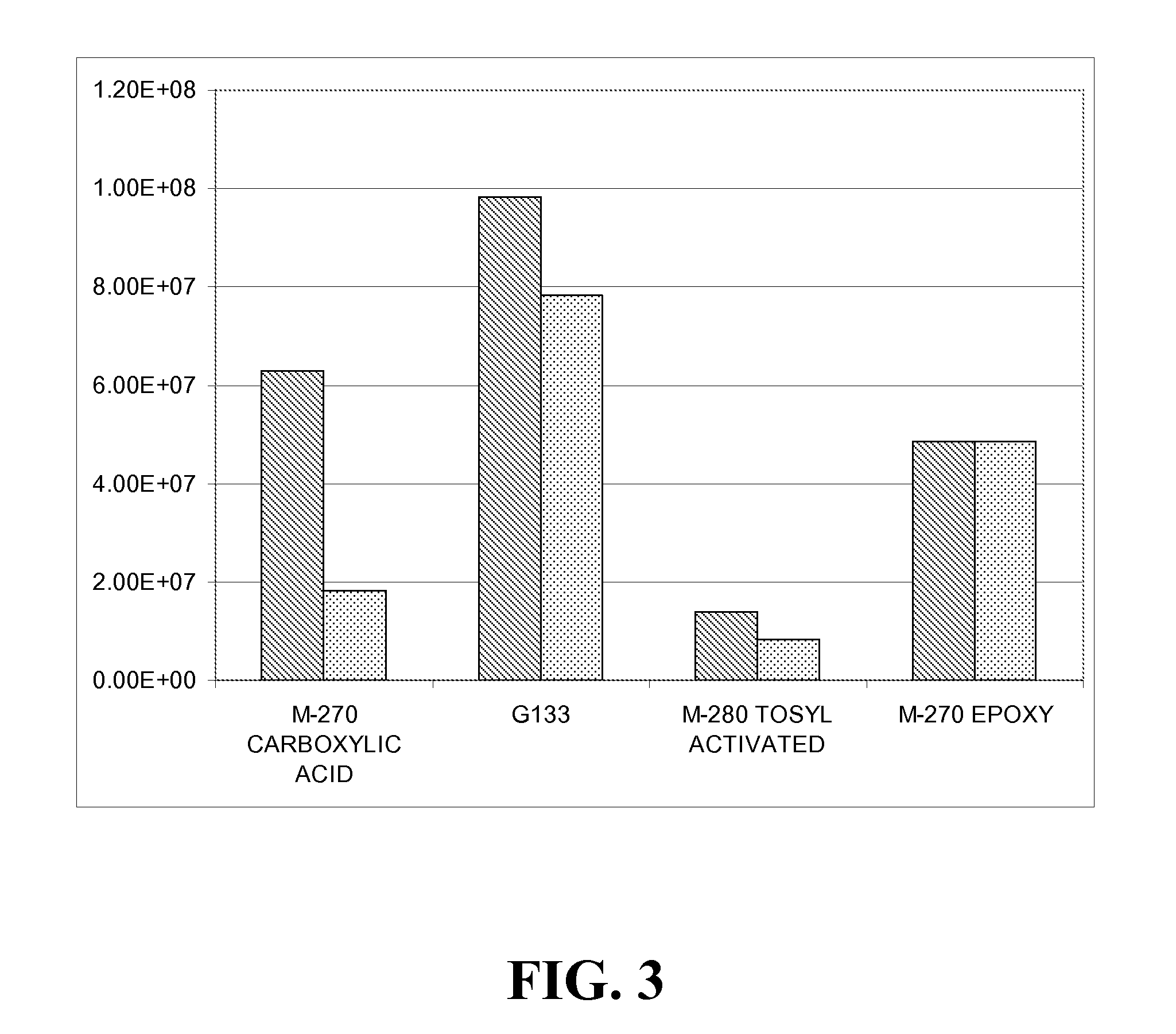Particles containing multi-block polymers
a multi-block polymer and particle technology, applied in the field of magnetic polymer particles carrying multi-block vinylic polymers, can solve the problems of limited binding partner, target binding strength, and materials that are not suitable for diagnostic assay procedures, and achieve the effect of facilitating the use of polymer particles
- Summary
- Abstract
- Description
- Claims
- Application Information
AI Technical Summary
Benefits of technology
Problems solved by technology
Method used
Image
Examples
example 1
Preparation of Multi-Block Polymer on a Polymer Particle
[0136]5 g (Dry Substance weight, DS) Magnetic Beads (Dynabeads® M-270 amine) were washed with THF (5 times, 15 ml / g DS each time). The DS weight was adjusted to 30% (the volume of the mix of solvent and beads was reduced by removing the supernatant until a 30 wt % beads in solvent mix was achieved) and treated with Argon (14 ml / minute), for 30 minutes. The resulting polymer particles were contacted with 0.19 mmol / g (DS) of alpha-bromoisobutyrate bromide (BrC(CH3)2C(O)Br).
[0137]The reaction mixture was treated with 14 ml / minute of Argon, for 30 minutes and added to a roundbottle reaction flask. It was stirred at 250 rpm, maintained at 0° C. with Argon flow of 14 ml / minute in the suspension for 120 minutes. The mixture was placed on a magnet and the supernatant removed to form a particle suspension.
[0138]1.8 g DMSO, 0.19 mmol / g (DS) CuBr and 3.43 mmol / g (DS) N-hydroxysuccinimide methacrylate (NHSMA) were mixed and 0.19 mmol / g (DS...
example 2
Formation of Hydrophilic and Charged Blocks
[0142]The polymer particles of example 1, carrying multiblock polymers where reacted with 12 g / g DS ethanolamine and the suspension heated to 60° C. for 2.5 h. The solution was washed 4 times with 1M NaOH, and stirred at 200 rpm over night. The solution was then washed with 0.01M NaOH. The resulting polymer is shown below.
[0143]The carboxylic acid groups in the outer block were measured by a titrating method to determine the amount of carboxylic groups on the particles. Acid groups measured on G133, example 1: 0.011 mmol acid groups / g DS.
example 3
Preparation of Multi-Block Polymer on a Polymer Particle
[0144]The procedure of examples 1 and 2 was repeated except that 1.04 mm / g DS NHSMA and 0.67 mmol / g(DS) tertbutylmethacrylate were used. The formed polymers formed are shown below:
[0145]The acid groups were measured to be: 0.09 mmol acid groups / g DS. In the polymer structures: n=10; m=7; n is the (number average) number of how many NHSMA monomer units theoretically attach to each other to make the polymer; and m is the (number average) number of how many tBMA monomer units theoretically attach to each other to make the polymer.
PUM
| Property | Measurement | Unit |
|---|---|---|
| molecular weight | aaaaa | aaaaa |
| diameter | aaaaa | aaaaa |
| diameters | aaaaa | aaaaa |
Abstract
Description
Claims
Application Information
 Login to View More
Login to View More - R&D
- Intellectual Property
- Life Sciences
- Materials
- Tech Scout
- Unparalleled Data Quality
- Higher Quality Content
- 60% Fewer Hallucinations
Browse by: Latest US Patents, China's latest patents, Technical Efficacy Thesaurus, Application Domain, Technology Topic, Popular Technical Reports.
© 2025 PatSnap. All rights reserved.Legal|Privacy policy|Modern Slavery Act Transparency Statement|Sitemap|About US| Contact US: help@patsnap.com



